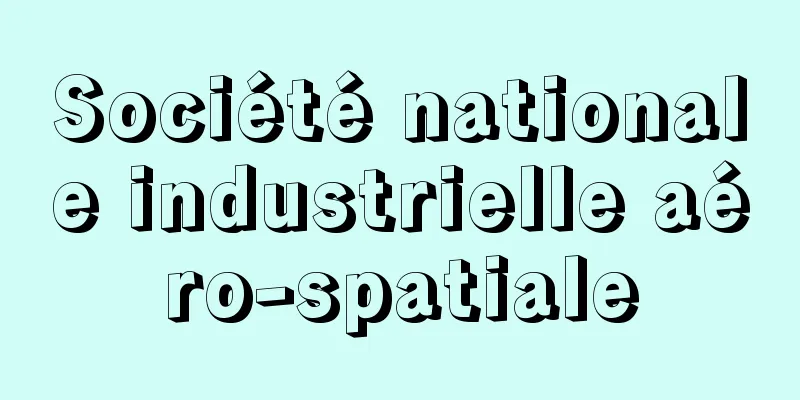Air pollution

|
Air pollution refers to air pollution caused by natural or artificial causes. It is also called air pollution. Generally, polluted air is formed by floating solid matter such as dust, smoke, and microorganisms, or by the presence of gaseous substances other than the gases that normally compose air. Substances that pollute the air in this way are called pollutants, and the source of pollutants is called the pollution source. [Hiroshi Matano] Sources and PollutantsPollution sources are broadly divided into natural sources such as volcanic eruptions and man-made sources such as fuel combustion. In the past, coal was used as the main energy source, and solid substances such as soot and dust were the main pollutants. However, since the 1950s, petroleum has been consumed in large quantities, and gaseous substances such as sulfur oxides have become the main pollutants. Primary pollution, such as soot and sulfur oxides, is emitted from the pollution source and becomes a pollutant as it is. On the other hand, secondary pollution is pollutants that react in the atmosphere after being emitted from the pollution source and become a completely different substance. Oxidants, which are produced by photochemical reactions caused by ultraviolet rays from the sun when hydrocarbons and nitrogen oxides emitted from automobiles and factories are emitted from automobiles and factories, are secondary pollutants. Pollutants are carried downwind by the wind in the atmosphere and are widely dispersed by wind turbulence, settled by gravity, and washed away by precipitation. The concentration of pollutants is greatly affected by weather conditions. The possibility of high concentrations of air pollution occurring given meteorological conditions is called air pollution potential. Generally, high concentrations of air pollution are more likely to occur when the wind is weak and a ground inversion is formed. In other words, this occurs when pollutants are trapped in the air layer close to the ground. Such meteorological conditions are often associated with high pressure, but can also be associated with a weak pressure trough or front. The relationship between pollutant concentrations and meteorological conditions is quite complex, with the influence of topography also taking place. [Hiroshi Matano] Anti-Pollution MeasuresAccurate air pollution meteorological surveys are necessary to implement appropriate pollution control measures when selecting factory sites or planning cities. This type of survey is also necessary to make effective air pollution potential forecasts. Based on synoptic meteorological conditions (pressure distribution, frontal positions, etc.), thorough investigations are carried out on the wind direction, wind speed, and vertical distribution of temperature in the target area, the formation, maintenance and dissolution of inversion layers, the duration of weak winds, the characteristics of land and sea breezes and other local winds, etc. Since the 1970s, the main method used has been to perform numerical simulations under appropriate boundary conditions and reflect the results in the forecast. A major practical difficulty in estimating the concentration of pollutants is that the direction of the main axis from the pollution source changes in a complex manner as the pollutants are diffused through the atmosphere and transported by air currents, making it difficult to pinpoint the polluted space. In addition, if the pollutants remain in the air for a long time and are transported long distances, causing the polluted space to spread internationally, international cooperation is necessary to solve the pollution problem. For this reason, the World Meteorological Organization (WMO) established an international pollution observation network in the 1960s and officially launched the World Climate Programme in 1979 with the aim of evaluating unconscious anthropogenic changes in the climate caused by human social activities and preserving the global environment. Since the first Climate Conference in the same year, the World Climate Conference has been held every 10 years to evaluate the progress of the World Climate Programme over the past 10 years and to determine how to promote it in the future. [Hiroshi Matano] "Atmospheric Environment Theory" by Takeshi Kawamura (1987, Asakura Publishing)" ▽ "Introduction to Environmental Studies" by Shinichi Okamoto, Yoichi Ichikawa, and Shinya Nagasawa (1996, Sangyo Tosho)" ▽ "Air Pollution" by Jane Walker, translated by Noriko Nishida (1996, Kaiseisha)" ▽ "Acid Rain and Air Pollution" by Masamitsu Kataoka and Hiroshi Takeuchi, supervised by Mitsuhiko Taga (1998, Sankyo Publishing)" ▽ "Chemical Engineering for Clean Air" by Masatake Sadakata (1999, Baifukan)" ▽ "History of Air Pollution in Japan" 3 volumes, planned by the Public Health Association and edited by the Research Committee for Historical Materials on Atmospheric Environment (2000, Latisse, Maruzen)" ▽ "Wide-area Air Pollution - From its Mechanisms to its Impact on Plants" by Shinji Wakamatsu and Mitsuo Shinozaki (2001, Shokabo)" ▽ "Basic knowledge of air pollution countermeasures" edited by the Environmental Conservation Measures Study Group, 2nd edition (2001, Industrial Environmental Management Association)" ▽ "Air Pollution Legislation Study Group, edited by the Air Pollution Situation in Japan, various editions (Gyosei)" [References] | | | | | | | | | |Source: Shogakukan Encyclopedia Nipponica About Encyclopedia Nipponica Information | Legend |
|
自然または人工的な原因によって大気が汚染されることをいう。空気汚染ともいう。一般に、汚染された大気中では、塵埃(じんあい)、煙、微生物などの固形質が浮遊したり、通常の空気を組成する気体以外のガス状質が混在して、汚染を形成している。このように大気を汚染している物質を汚染質といい、汚染質の発生源を汚染源という。 [股野宏志] 汚染源と汚染質汚染源は、火山の噴火などの自然的なものと、燃料の燃焼などの人為的なものとに大別される。昔は石炭がおもなエネルギー源として使用されたため、煤煙(ばいえん)や煤塵(ばいじん)など固形質が主要な汚染質であったが、1950年代以降は石油類が多量に消費され、硫黄(いおう)酸化物などガス状質が主要な汚染質となっている。煤煙や硫黄酸化物のように、汚染源から排出されてそのまま汚染質となるものを一次汚染質という。一方、汚染源から排出されたあと、大気中で反応を受け、まったく別な物質の汚染質となったものを二次汚染質という。自動車や工場などから排出された炭化水素と窒素酸化物が、太陽の紫外線による光化学反応をおこしてつくりだすオキシダントは二次汚染質である。汚染質は大気中で、風によって風下に運ばれ、風の乱れによって広く拡散されるほか、重力によって沈降し、降水によって洗浄される。汚染質の濃度は気象条件によって大きく左右される。気象条件からみて高い濃度の大気汚染がおこる可能性を大気汚染ポテンシャルという。一般に、高い濃度の大気汚染がおこりやすいのは、風が弱く、接地逆転が形成されているときである。つまり、汚染質が地面近くの気層に閉じ込められるような場合である。このような気象条件は、高気圧に関連することが多いが、弱い気圧の谷や前線に関連することもある。汚染質の濃度と気象条件との関係は、地形の影響も加わって、かなり複雑である。 [股野宏志] 汚染対策工場敷地の選定や都市計画にあたって、適切な汚染対策を行うためには、精密な大気汚染気象調査が必要である。また、有効な大気汚染ポテンシャル予報を行う場合にも、この種の調査が必要である。これには総観的な気象状態(気圧配置や前線の位置など)に基づき、対象地域の風向、風速、気温の鉛直分布、逆転層の形成と維持および解消、弱風の継続時間、海陸風その他の局地風の特性などについて十分な調査が行われる。1970年代以降は、適当な境界条件を与えて数値シミュレーションを行い、その結果を予報に反映する方法がおもに用いられている。 汚染質の濃度を推定する場合の実際的な大きな困難は、汚染質が大気の拡散や大気の流れによって運ばれる過程で、汚染源からの主軸の方向が複雑に変化するために、汚染空間を精確に特定できないことである。また、汚染質の滞空時間が長く、汚染質が長距離輸送されて汚染空間が国際的に広がった場合には、汚染問題の解決に国際的な協力が必要である。このため、世界気象機関(WMO)は1960年代に汚染観測網を国際的に整備するとともに、人間の社会活動に伴う気候の無意識な人為的変動を評価して地球環境を保全することを目的に、1979年に世界気候計画を正式に発足させた。そして同年の第1回気候会議以後、10年ごとに世界気候会議が開催され、10年間の世界気候計画の進行状況の評価や今後の推進方法の策定などが行われている。 [股野宏志] 『河村武著『大気環境論』(1987・朝倉書店)』▽『岡本真一・市川陽一・長沢伸也著『環境学概論』(1996・産業図書)』▽『ジェーン・ウォーカー著、西田紀子訳『大気汚染』(1996・偕成社)』▽『多賀光彦監修、片岡正光・竹内浩士著『酸性雨と大気汚染』(1998・三共出版)』▽『定方正毅著『大気クリーン化のための化学工学』(1999・培風館)』▽『公健協会企画、大気環境学会史料整理研究委員会編『日本の大気汚染の歴史』全3冊(2000・ラテイス、丸善発売)』▽『若松伸司・篠崎光夫著『広域大気汚染――そのメカニズムから植物への影響まで』(2001・裳華房)』▽『環境保全対策研究会編『大気汚染対策の基礎知識』2訂版(2001・産業環境管理協会)』▽『大気汚染法令研究会編『日本の大気汚染状況』各年版(ぎょうせい)』 [参照項目] | | | | | | | | | |出典 小学館 日本大百科全書(ニッポニカ)日本大百科全書(ニッポニカ)について 情報 | 凡例 |
<<: Air Pollution Control Law - Taikiosenboushiho
>>: Atmospheric stability - atmospheric stability
Recommend
Giovan Francesco Straparola
Italian author. Born in Caravaggio in northern It...
Dentistry - Only
A branch of medicine that deals with the preventi...
Cikker, J.
…A Central European republic that existed from 19...
Mizuho Plateau
This plateau ice sheet area spreads south of Showa...
Alnico
...The mechanism behind this high coercive force ...
Groundbreaking ceremony
… The completed blocks are stacked by a crane on ...
diligence
…In England, in 1708, regular trains ran between ...
Yoshikawa [town] - Yoshikawa
A former town in Nakakubiki County, southwest of N...
Genetic code
A code recorded as the sequence of nucleotides in...
Dry gas meter - Dry gas meter
…Turbine meters use the flow of gas to turn an im...
Tungsten mineral - tungsten mineral
A general term for minerals whose main component i...
Magpie goose
A bird of the family Anatidae in the class Aves. ...
Commercial servant - shougyoushiyon
A person who is subordinate to a particular merch...
Fara
…Ancient Sumerian city in southern Mesopotamia. T...
Herwegh - Georg Herwegh
German poet. Born in Stuttgart. His "Poems o...








![Yuwaku [Hot spring] - Yuwaku](/upload/images/67cd15e49c05f.webp)
